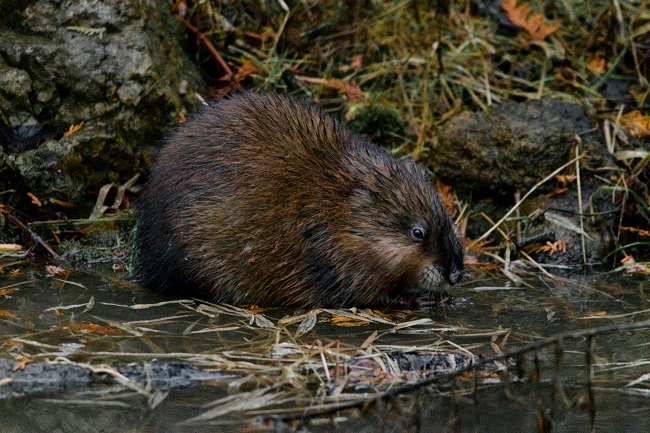
The American Muskrat, scientific name Ondatra zibethicus, is a fascinating semi-aquatic mammal native to North America. Known for its incredible adaptability and engineering prowess, the muskrat has become a prominent figure in the wetland ecosystems it inhabits. Let’s explore the characteristics, habitat, behavior, and ecological significance of this remarkable creature.
Physical Characteristics
The American Muskrat is a medium-sized rodent with a streamlined body, typically measuring about 16 to 28 inches in length, including the tail. It weighs between 1.5 to 4.5 pounds, with males being larger than females. The muskrat’s dense fur is usually dark brown, thick, and water-repellent, helping it to stay dry while spending much of its time in aquatic environments.
Habitat and Range
Muskrats are primarily found in wetlands such as marshes, ponds, lakes, rivers, and streams throughout North America, from Alaska and Canada to the southern United States. They are highly adaptable and can thrive in both freshwater and brackish environments. Their extensive range is a testament to their ability to colonize various habitats, making them one of the most widespread semi-aquatic mammals in North America.
Behavior and Lifestyle
Muskrats are predominantly nocturnal, although they may be active during the day in certain conditions. They are excellent swimmers, thanks to their webbed hind feet, which make them highly maneuverable in water. Their strong front claws aid in digging burrows, constructing dens, and building their characteristic dome-shaped lodges, which are typically made from plant material like cattails and reeds.
These lodges serve as shelter from predators and harsh weather, providing a secure and cozy space for the muskrats. They have underwater entrances, ensuring easy access to foraging areas and protecting them from potential threats. Muskrats are skilled divers, capable of holding their breath for up to 15 minutes, allowing them to search for food underwater.
Diet
Muskrats are herbivores and primarily consume vegetation. Their diet consists of various aquatic plants, such as cattails, water lilies, sedges, pondweeds, and bulrushes. They are also known to feed on the roots, stems, and leaves of these plants. Their voracious appetite for aquatic vegetation plays a vital role in wetland ecosystems, as they help regulate plant growth and maintain a healthy balance in these habitats.
Ecological Significance
The American Muskrat plays a significant role in wetland ecosystems. Their feeding habits help control the growth of aquatic plants, preventing overgrowth and maintaining the ecological balance of wetland habitats. By consuming plant material, muskrats indirectly contribute to nutrient cycling within wetlands.
Muskrat lodges also serve as mini ecosystems, providing shelter and nesting sites for other species such as turtles, birds, and fish. These lodges can become complex structures, with multiple chambers and entrances, creating a diverse array of microhabitats within wetlands.
In conclusion, the American Muskrat is an extraordinary creature well-adapted to aquatic environments. With its engineering skills, feeding habits, and influence on wetland ecosystems, the muskrat plays a vital role in the delicate balance of North America’s waterways.
7 Fun Facts About Muskrats
Aquatic Engineers
Muskrats are skilled engineers, building intricate lodges and burrows in wetland habitats. They use plant material, such as cattails and reeds, to construct their lodges, which can have multiple chambers and underwater entrances.
Diving Champions
Muskrats are excellent swimmers and divers. They can stay submerged for up to 15 minutes, allowing them to search for food underwater and evade predators.
Tail as a Rudder
The muskrat’s long, scaly tail serves multiple purposes. It acts as a rudder while swimming, helps with balance on land, and can even be used as a prop for grooming.
Teeth Growth
Like other rodents, muskrats have continuously growing incisor teeth. They must constantly gnaw on vegetation and other materials to keep their teeth from becoming too long.
Sort of Social Animals
Muskrats are generally solitary creatures, but they can form small family groups during certain times of the year. These groups usually consist of a breeding pair and their offspring from the previous year.
Nocturnal Lifestyle
While muskrats are mainly nocturnal, they may also be active during the day in certain conditions, such as when food is scarce or during the breeding season.
Multiple Nests
Muskrats may build several lodges or burrows within their territory. These serve as resting places, breeding sites, and protection from predators.
Related Articles & Free Email Newsletter Sign Up
The Badger is a Tenacious Guardian of the Ecosystem
The Remarkable Rise of the American Black Bear Population


Comment here